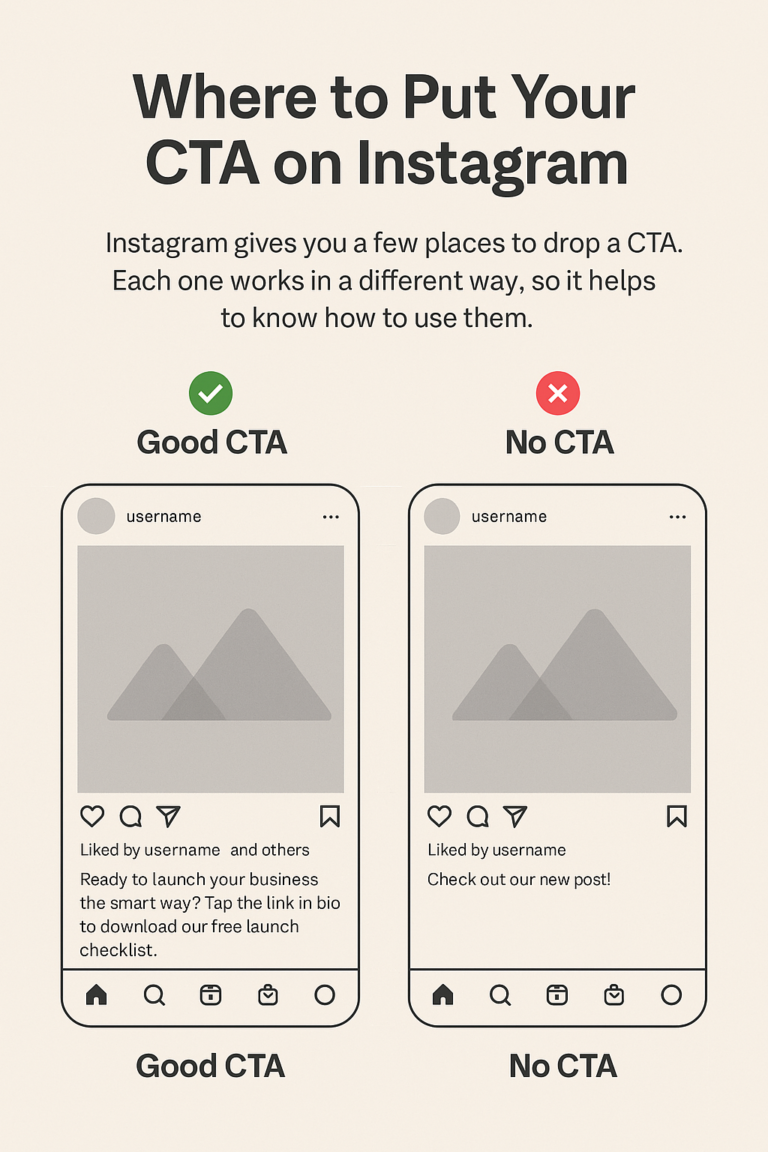Your content might be strong, your visuals might be on point, but if you’re not telling your audience what to do next—you’re leaving money (and growth) on the table.
If you want people to click, comment, buy, or even just save your post for later, you have to be direct. That’s where a Call to Action, or CTA, comes in.
In this guide, we’re breaking down how to write CTAs that actually work on Instagram, where to use them, and how to tweak them depending on your audience.
Whether you’re a brand, creator, or service-based business, this one’s for you.
What Is a Call to Action on Instagram?
A Call to Action is a short phrase that encourages your audience to take a step—big or small. It could be:
“Click the link in bio”
“DM us to book”
“Tag a friend who needs this”
Instagram doesn’t give you clickable links in every post, so a good CTA makes sure you don’t lose the viewer’s attention. It gives direction, adds purpose, and helps move your audience from just watching to actually doing.
Why CTAs Work (And Why You Need Them)
Here’s the deal: if you don’t ask, people won’t act. A CTA:
Helps your audience understand what to do next
Increases likes, comments, saves, and shares
Improves reach and visibility
Boosts website clicks and sales
Makes your content goal-driven
At Arrox Creative Marketing Studio, we’ve seen this firsthand. A good CTA can be the difference between someone scrolling past your post—or clicking through to book with you.
What Makes a Good CTA?
A strong CTA is:
✅ Clear – No vague language. Say exactly what you want people to do.
✅ Short – Don’t overcomplicate it. Keep it to 5–7 words.
✅ Benefit-focused – Tell them what they get out of it.
✅ Action-driven – Use strong verbs like “shop,” “save,” “book,” “download.”
✅ Matched to the goal – What do you want from the post?
Where to Put Your CTA on Instagram
Instagram gives you a few places to drop a CTA. Each one works in a different way, so it helps to know how to use them.
1. In Your Captions
This is the most common place—and one of the most powerful. The best captions use a hook to pull the reader in, then a clear CTA at the bottom.
Example:
“Ready to launch your business the smart way?
Tap the link in bio to download our free launch checklist.”
Use line breaks, bold emojis, and spacing to make your CTA stand out.
2. In Instagram Stories
Stories give you tools like link stickers, polls, and questions. They’re perfect for quick action.
Examples:
“Vote in the poll 👇”
“Tap to grab the template”
“DM us for the discount code”
Make your Story CTA feel like a casual nudge, not a hard sell.
3. In Reels (Text or Voiceover)
Reels are your best shot at reach. But reach means nothing if no one acts.
Tips:
Add text like “Watch till the end” or “Save this Reel”
Use a voiceover to say what you want viewers to do
Drop a CTA in the caption, too
Example:
“Love this tip? Save it now so you don’t forget it later.”
4. In Your Instagram Bio
This is one of the only spots you get a clickable link on Instagram. Use it wisely.
Pair your link with a short CTA above it.
Examples:
“🎁 Free workbook below”
“👇 Book your free call”
“Join the waitlist”
5. In Instagram Ads
Running ads? You get actual CTA buttons like “Shop Now” or “Download.”
Use them with intention.
Cold audiences might need a softer CTA like:
“Learn more about what we offer”
Hot audiences are ready for:
“Grab your spot now—only 3 left!”
Match Your CTA to the Right Audience
Not every person who sees your content is at the same stage. Some just found you. Others are long-time followers. Your CTA should reflect that.
| Audience | Best CTA Style |
|---|---|
| Cold (New viewers) | “Follow for more tips” / “Check out the link in bio” |
| Warm (Followers) | “DM us for the PDF” / “Save this tip for later” |
| Hot (Ready to buy) | “Book your session” / “Sign up now – 2 spots left” |
40+ CTA Examples You Can Steal Today
💬 For Engagement
“Drop a 🔥 if this helped you”
“Tag a friend who needs this”
“Double tap if you agree”
“What’s your biggest takeaway?”
“Comment below – we’re replying to everyone”
📌 For Saves & Shares
“Save this post to revisit later”
“Share this with your team”
“You’ll want this when you’re ready to launch”
🎯 For Conversions
“Book your free call – link in bio”
“Get your discount – DM us ‘CODE’”
“Click the link to shop now”
“Join our free 5-day challenge”
📱 For Stories
“Tap the link – offer ends today”
“Vote in the poll 👉”
“Slide up for the checklist”
“Ask me anything 👇”
📈 For Reels
“Watch to the end 👀”
“Save this Reel for later”
“Tag your accountability buddy”
“Sound on 🔊 for a surprise”
🔗 For Your Bio
“👇 Free guide below”
“Start here if you’re new”
“Join 1,000+ people getting smarter about marketing”
What Not to Do With CTAs
🚫 Don’t be vague
“Click here” doesn’t say anything. Be specific.
🚫 Don’t ask for too much
One post = one main CTA. Don’t overload.
🚫 Don’t ignore your audience tone
Keep it friendly and natural—like how you’d talk to them in real life.
How to Track CTA Success
Use Instagram Insights to see how your CTA is doing. Look for:
Link clicks
Saves
Comments
Story interactions
For links in bio, use a free tool like Bitly or UTM links so you can see exactly what’s working.
CTA Best Practices We Use at Arrox Studio
We’ve run dozens of content campaigns for brands and creators. Here’s what we’ve learned:
✅ Repeat your CTA more than once
Add it in the Reel, the caption, and in the first Story frame.
✅ Make it visual
Use emojis, bold fonts, and movement to draw attention.
✅ Test different formats
Some audiences respond better to Reels, others love a poll or Story quiz.
✅ Make it feel casual
People don’t want to be sold to. Keep it conversational.
Final CTA (because we practice what we preach 😎)
Want help creating content that not only looks good but actually gets results?
We build scroll-stopping strategies that turn followers into leads, leads into customers, and customers into fans.
👉 Book a free discovery call with Arrox Creative Marketing Studio
Located in Vancouver, BC, and working with brands worldwide.


